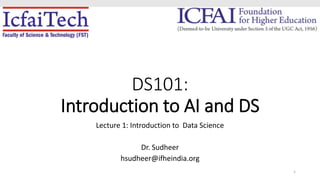
Lecture_1_Intro_toDS&AI.pptx
- 1. DS101: Introduction to AI and DS Lecture 1: Introduction to Data Science Dr. Sudheer hsudheer@ifheindia.org 1
- 2. 2 Course Code Course Title L P U DS101 Introduction to Data Science and Artificial Intelligence 3 0 3 Team of Instructors: 1. Ms Sathya AR 2. Ms. P Rohini 3. Dr. H Sudheer 4. Dr. P. Sirisha Course Objective: 1. The objective of this course is to expose the students to fundamental concepts of data science and their implementation using Python programming. 2. Introduce the mathematical foundations required for data science 3. To explore the various data pre-processing techniques 4. To Summarize the aspects of exploratory data analysis (EDA): Uses of EDA; Role of metadata in EDA; Data transformations identified through EDA. 5. To understand the AI approaches in Data Science.
- 3. 3 Textbook (s) T1 Cathy O’Neil and Rachel Schutt, “Doing Data Science, Straight Talk From The Frontline”, O’Reilly, 2014. T2 Artificial Intelligence A Modern Approach, by Stuart Russell and Peter Norvig, 3 rd Edition, Pearson Education, 2010, ISBN 13:978-0-13-604259-4. Reference Book(s) R1 Python Data Science Handbook, Essential Tools for Working with Data, Jake VanderPlas,Orielly, 2017 R2 Data Science from Scratch: FIRST PRINCIPLES WITH PYTHON, Joel Grus, Orielly,2019 R3 The Data Science HandBook, Field Cady ,Wiley,2017 R4 Jiawei Han, Micheline Kamber and Jian Pei, “ Data Mining: Concepts and Techniques”, Third Edition. ISBN 0123814790, 2011 Online Resources R5 https://onlinecourses.nptel.ac.in/noc22_cs72/preview R6 https://www.udemy.com/course/complete-python-bootcamp/ R7 https://lms.simplilearn.com/courses/4227/Introduction-to-Data- Science/syllabus
- 4. 4 “Data is the new oil. It’s valuable, but if unrefined it cannot really be used. It has to be changed into gas, plastic, chemicals, etc to create a valuable entity that drives profitable activity; so must data be broken down, analyzed for it to have value.” — Clive Humby, 2006
- 5. 5 Increasingly many companies see themselves as data driven.
- 6. 6
- 7. Data Science is the science which uses computer science, statistics and machine learning, visualization and human-computer interactions to collect, clean, integrate, analyze, visualize, interact with data to create data products. Data science is an interdisciplinary field that uses scientific methods, processes, algorithms and systems to extract knowledge and insights from noisy, structured and unstructured data] and apply knowledge from data across a broad range of application domains. Data science is related to data mining, machine learning and big data. SOURCE : WIKIPIDEA 7
- 8. Big Data and Data Science Hype 8
- 9. “Big Data” Sources Every: Click Ad impression Billing event Fast Forward, pause,… Server request Transaction Network message Fault … User Generated (Web & Mobile) …. . Internet of Things / M2M Health/Scientific Computing It’s All Happening On-line
- 11. 11
- 12. The Current Landscape (with a Little History) 12 Data science is a broad field that refers to the collective processes, theories, concepts, tools and technologies that enable the review, analysis and extraction of valuable knowledge and information from raw data. Source: Techopedia Drew Conway’s Venn diagram of data science
- 13. Rise of the Data Scientist 13 skills of Data Geeks: Statistics – traditional analysis you’re used to thinking about Data Munging – parsing, scraping, and formatting data Visualization – graphs, tools, etc. Harvard Business Review declared data scientist to be the “Sexiest Job of the 21st Century”. https://hbr.org/2012/10/data-scientist-the-sexiest-job-of-the-21st-century
- 14. The Role of the Social Scientist in Data Science 14 Both LinkedIn and Facebook are social network companies. Often‐ times a description or definition of data scientist includes hybrid sta tistician, software engineer, and social scientist. If they’re social science-y problems like friend recommendations or people you know or user segmentation, then by all means, bring on the social scientist! Social scientists also do tend to be good question askers and have other good investigative qualities, so a social scientist who also has the quantitative and programming chops makes a great data scientist.
- 15. Data Science Jobs 15 Most of the job descriptions: they ask data scientists to be experts in computer science, statistics, communication, data visualization, and to have extensive domain expertise. Nobody is an expert in everything, which is why it makes more sense to create teams of people who have different profiles and different expertise together, as a team, they can specialize in all those things. A Data Science Profile : • Computer science • Math • Statistics • Machine learning • Domain expertise • Communication and presentation skills • Data visualization
- 16. Rachel’s data science profile, which she created to illustrate trying to visualize oneself as a data scientist; she wanted students and guest lecturers to “riff” on this—to add buckets or remove skills, use a different scale or visualization method, and think about the drawbacks of self- reporting 16
- 17. Data science team profiles can be constructed from data scientist profiles; there should be alignment between the data science team profile and the profile of the data problems they try to solve 17
- 18. Data science workflow 18 Section 2 https://cacm.acm.org/blogs/blog-cacm/169199-data-science- workflow-overview-and-challenges/fulltext
- 20. Data science workflow 20 Digging Around in Data Hypothesize Model Large Scale Exploitation Evaluate Interpret Clean, prep
- 21. What is hard about Data Science 21 • Overcoming assumptions • Making ad-hoc explanations of data patterns • Overgeneralizing • Communication • Not checking enough (validate models, data pipeline integrity, etc.) • Using statistical tests correctly • Prototype Production transitions • Data pipeline complexity (who do you ask?)
- 22. What is hard about Data Science 22
- 23. What are Data Scientists really doing? 23 Section 2 https://visit.figure-eight.com/rs/416-ZBE- 142/images/CrowdFlower_DataScienceReport_2016.pdf
Notas do Editor
- Ronny Kohavi* keynote at KDD 2015 People are incredibly clever at explaining “very surprising results”. Unfortunately most very surprising results are caused by data pipeline errors. Beware “HiPPOs” (Highest Paid-Person’s Opinion)
- Quote from paper “I’d rather the data go away than be wrong and not know” Assumptions not communicated: transformations not documented.
- Quote from paper “I’d rather the data go away than be wrong and not know” Assumptions not communicated: transformations not documented.